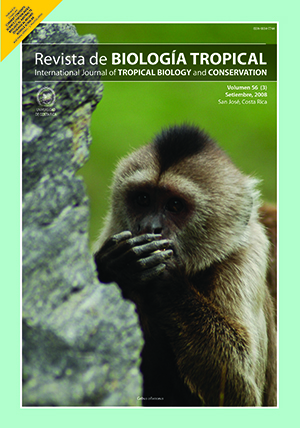Abstract
Because of their slow growth, shade-tolerant species remain exposed to foliar damage long before reproductive age. Foliar damage can be controlled through synchronous leaf produc-tion and specialized phytochemical strategies. in this study, the dynamics of foliar damage in different cohorts of seedlings were evaluated to determine if the High-Andean species, Clusia multiflora (Clusiaceae) and Drimys granadensis (Winteraceae) appeal to the synchronous leaf production for controlling the herbivory and patho-genical damage, and to establish the possible relations between the healthy state, growth and mortality of seed-lings. Since a recently-emerged seedling could not supply the physiological costs of specialized strategies, we expected the highest synchronous leaf production in the youngest individuals, and differences between cohorts in foliar damage. Four variables were measured to evaluate the health state along time, in three cohorts of seed-lings: Proportion of predated leaves (Pp), proportion of healthy leaves (Ps), proportion of leaves with symptoms of disease or punctual damage (Pe) and growing (% increment of height). Both species showed significant differ-ences between periods in the proportion of healthy leaves, but there was not an effect of time-cohort interaction, therefore synchronic production of leaves was not a strategy more used for any particular cohort. Foliar damage oscillated along time, fact that can be explained by the pulses of leaf production. However, this strategy had little efficiency to control the pathogen attack. in general, the unified behavior of all variables was affected by cohort, time, species an all the different interactions. Association between growing and foliar damage were conditioned by climate. The highest mortality ocurred during the dry season, and one fourth of the D. granadensis deaths were caused by the joint action of herbivory and drought. Results suggest that in spite of the synchronous leaf production in all cohorts, this strategy quickly loses the efficiency for controlling foliar damage, because the means of Ps were below of 0.25 at the end of the monitoring period. The differences between species in the dynamics of health state should explain partially their coexistence in the High-Andean forest.
##plugins.facebook.comentarios##

This work is licensed under a Creative Commons Attribution 4.0 International License.
Copyright (c) 2008 Revista de Biología Tropical






